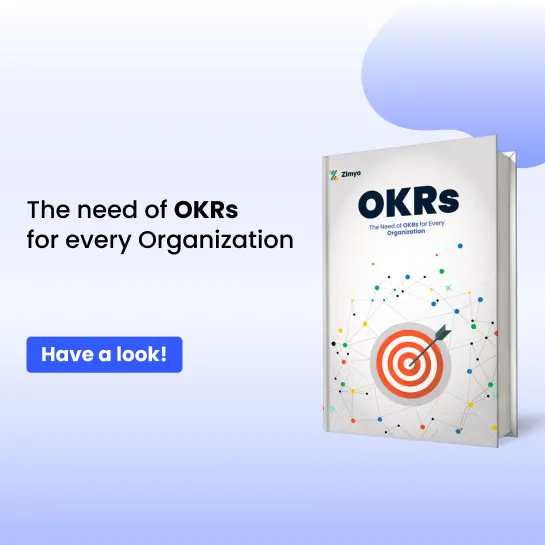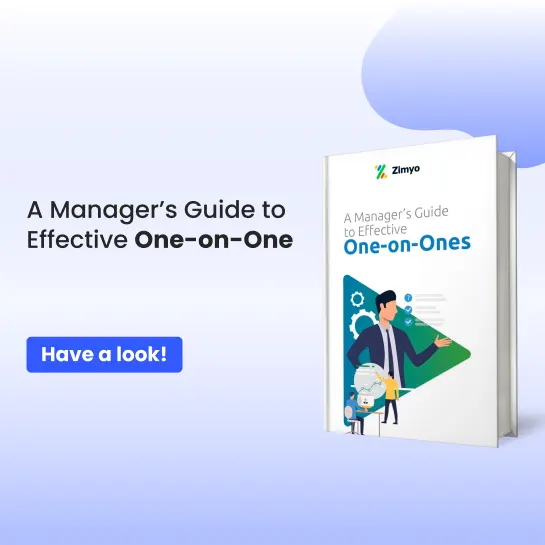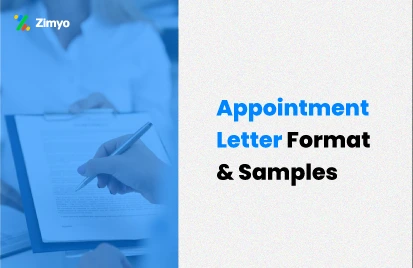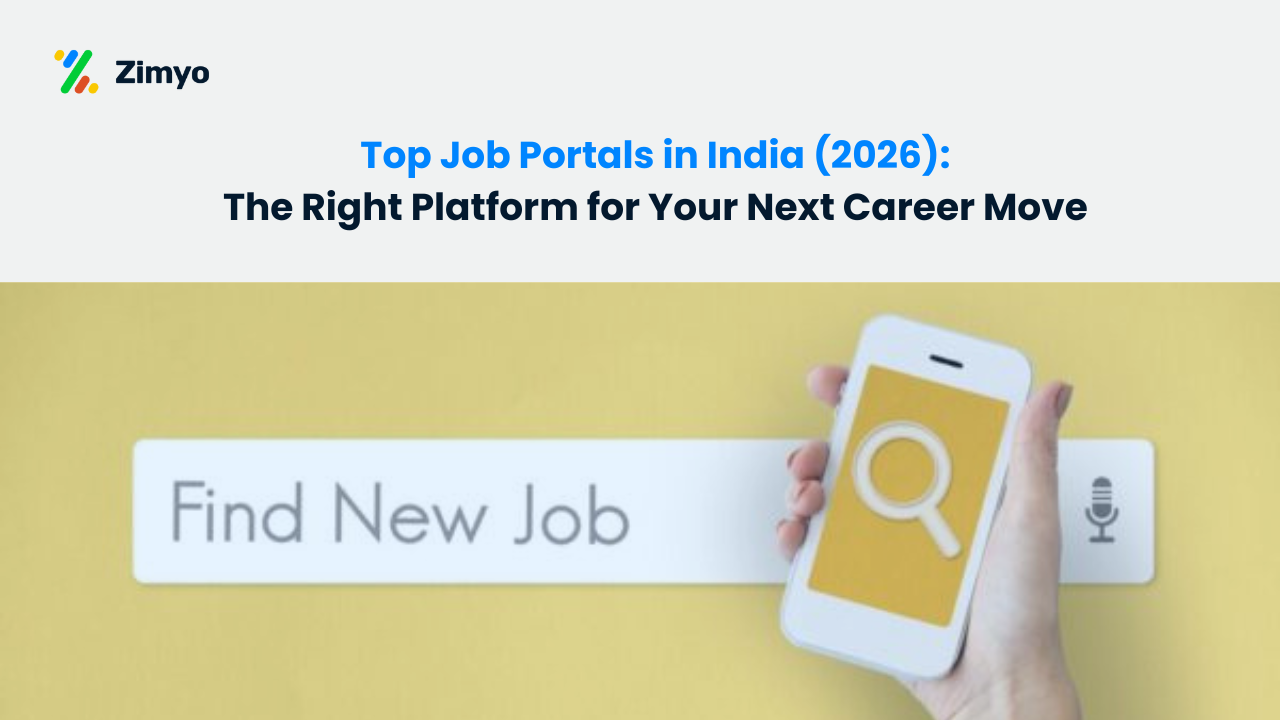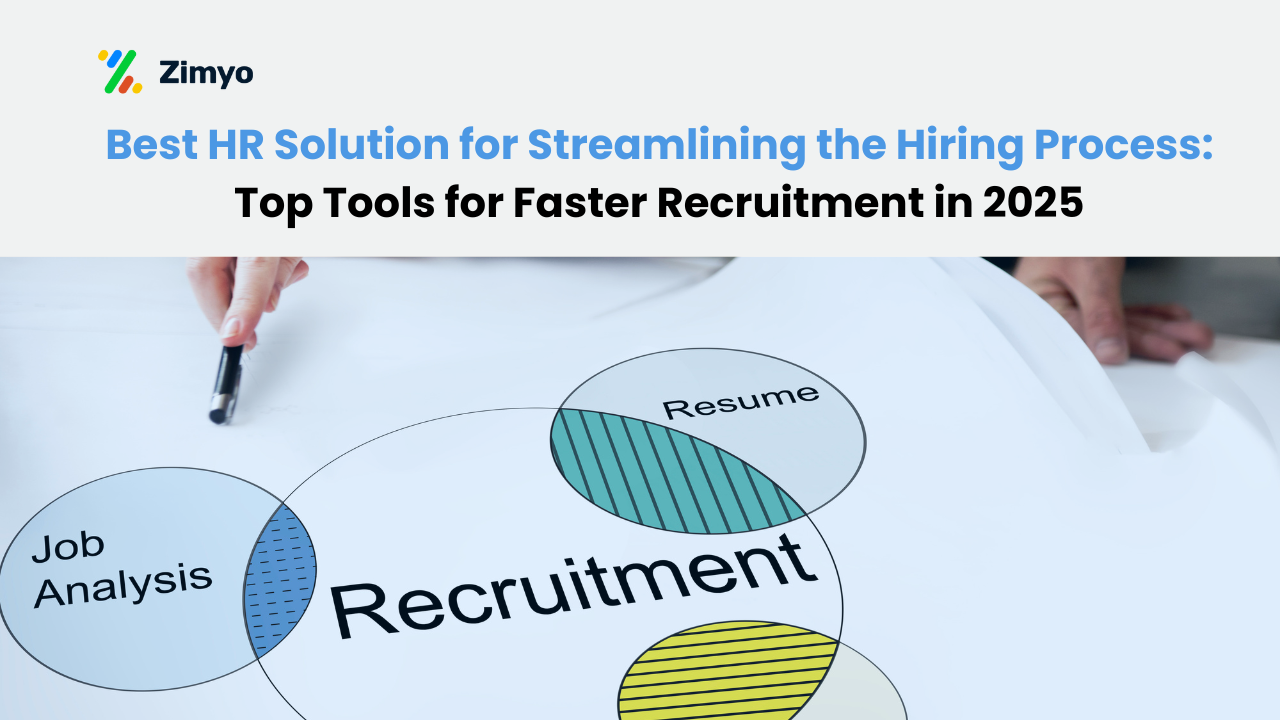It’s your first day at a new job. You’re walking into the office (or logging into your company’s virtual platform) feeling a mix of excitement and nervousness. You don’t know where the coffee machine is, you have no idea who’s who, and the company’s internal tools look like a foreign language.
Now imagine this instead, someone warmly greets you, hands you a new employee orientation program sample pdf, gives you a tour, introduces you to your teammates, explains how things work, and makes you feel welcome from the very first moment. That’s the magic of a well-designed Employee Orientation Program.
In this blog, we’ll explore everything you need to know about designing, running, and improving your orientation program for new employees so they feel valued, confident, and ready to contribute from day one.
Introduction to Employee Orientation Program

What is the Meaning of Employee Orientation Program in Layman Terms?
In layman’s terms, an Employee Orientation Program is like a welcome guide for new employees.
It’s the process where a company introduces a new hire to their job, the people they’ll work with, the company’s rules, culture, and expectations. Think of it as the “first-day (or first-week) crash course” that helps someone feel comfortable, understand how things work, and start doing their job confidently.
It’s basically the company’s way of saying, “Welcome aboard, here’s everything you need to know to get started!”
What is the Official Definition of Employee Orientation Program?
The official definition of an Employee Orientation Program can be stated as:
An Employee Orientation Program is a structured process used by organizations to introduce new employees to their roles, responsibilities, colleagues, workplace policies, and the organizational culture, with the goal of facilitating a smooth transition into the company and enhancing job performance.
Society for Human Resource Management (SHRM)
This type of definition is widely aligned with HR standards and professional references such as the Society for Human Resource Management (SHRM) and similar authoritative bodies.
Want to get more insights about employee orientation? Get the detailed Meaning and Definition of employee orientation.
What Orientation Matters for Both Employers and Employees?
Orientation matters for both employers and employees because it sets the tone for the entire working relationship.
For employees, a well-structured Employee Orientation Program reduces anxiety, answers common questions, and helps them feel welcomed and confident in their new role. It gives them clarity about their responsibilities, introduces them to workplace culture, and connects them with the right people and resources from day one.
For employers, orientation ensures that new hires understand company policies, values, and expectations right away. It boosts productivity, reduces mistakes, and increases employee engagement and retention. A strong orientation program also helps build trust, prevents confusion, and saves time in the long run by minimizing repeated explanations or miscommunications.
In short, orientation is a win-win, employees feel supported, and employers get better performance and loyalty.
Did you now we can onboard new employees with an automates virtual system too? Learn how to Onboard New Employees With HRMS
Quick Stats on Employee Orientation Program Success
- Organizations with a structured onboarding process improve new hire retention by up to 82% and see 70% higher productivity, according to Brandon Hall Group.
- 69% of employees are more likely to stay with a company for three years if they experience effective onboarding.
- 77% of new hires consider onboarding critical in deciding whether to stay long-term.
- 50% of employee turnover happens within the first 90 days if onboarding is poor.
- Only 12% of employees believe their company does a great job with onboarding.
- 53% of HR professionals report improved employee engagement thanks to better onboarding.
- Pairing new hires with a mentor or “buddy” boosts productivity in 97% of cases at Microsoft.
- Nearly one-third of all attrition happens within the first 90 days—highlighting the cost of ineffective orientation.
Key Objectives of an Employee Orientation Program
Every new hire orientation process should aim to:
- Familiarize employees with the company’s mission, vision, and values.
- Provide clarity on job responsibilities and expectations.
- Explain company policies, benefits, and compliance requirements.
- Build relationships with colleagues and managers.
- Ensure access to the tools and resources needed for daily work.
Difference between Orientation and Onboarding
|
Aspect |
Employee Orientation |
Onboarding |
|
Definition |
A short-term, structured introduction for new hires to learn about the company, policies, and basic role expectations. |
A long-term process that integrates new hires into the organization, helping them adapt to their role, team, and culture. |
|
Duration |
Usually lasts a few hours to a few days. |
Can last several weeks to months, sometimes up to a year. |
|
Focus |
Provides basic information about the company, policies, benefits, and compliance requirements. |
Focuses on role-specific training, performance expectations, integration into team, and career development. |
|
Purpose |
To make new employees aware of company rules, values, and resources. |
To help employees become fully productive, engaged, and aligned with the organization’s culture. |
|
Activities |
Presentations, policy reviews, workplace tours, team introductions. |
Hands-on training, mentorship programs, project assignments, performance reviews. |
|
Outcome |
Employee understands the company structure, policies, and their basic responsibilities. |
Employee feels fully integrated, confident in their role, and committed to the organization. |
|
Example |
A one-day session where HR explains benefits, workplace rules, and company history. |
A 90-day plan including shadowing senior colleagues, skill development, and regular check-ins with managers. |
Importance of an Employee Orientation Program
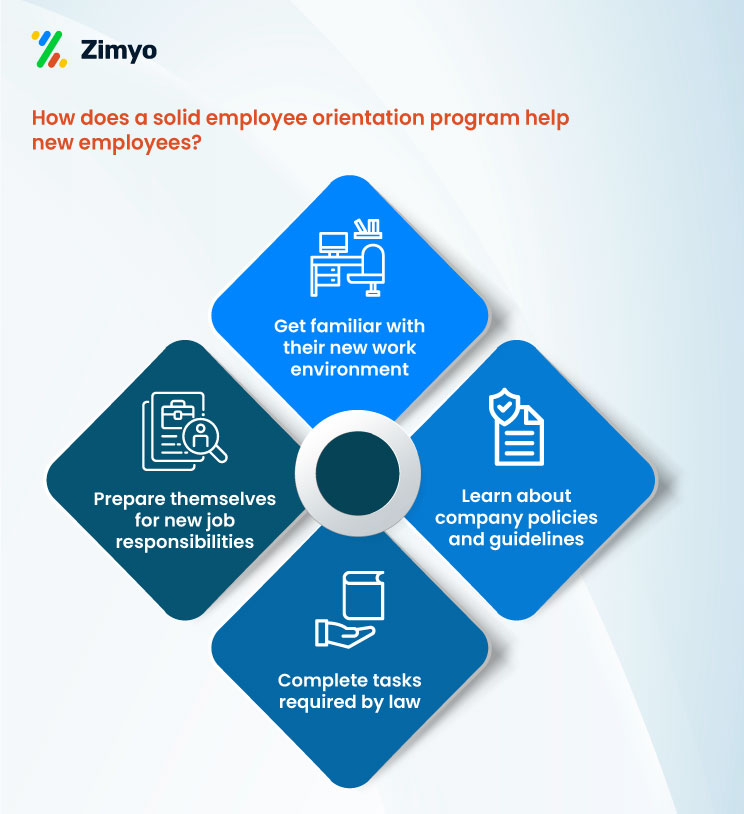
A strong Employee Orientation Program isn’t just “nice to have”—it’s a game changer for:
- First impressions: It sets the tone for the employee’s entire journey.
- Retention: Employees who go through proper orientation program samples are more likely to stay long-term.
- Productivity: With the right information early on, employees become effective faster.
- Culture fit: They quickly understand the values, mission, and work style of the organization.
Types of Employee Orientation Programs
- Formal Orientation – A structured program with presentations, checklists, and schedules.
- Informal Orientation – Casual discussions, team lunches, and one-on-one guidance.
- On-the-Job Orientation – Learning directly while performing job tasks.
- Online Orientation – Virtual programs, often supported with an orientation program sample or new employee orientation program sample pdf.
Key Elements of an Effective Employee Orientation Program
When creating an Employee Orientation Program, it’s important to design it in a way that makes new hires feel welcome, informed, and confident in their roles. Whether you’re working on an orientation program for new employees or looking at a new employee orientation program sample PDF for inspiration, these are the must-have elements that ensure a smooth new hire orientation process.
1. Welcome and Introductions
The very first step of an Employee Orientation Program is a warm welcome. This can include a personal greeting from the manager, a short speech from company leaders, and icebreaker activities to make new hires feel comfortable. In any orientation program sample, you’ll notice that the introduction phase sets the tone for the entire day. This is also the time to introduce the orientation program for new employee sample schedule so they know what to expect.
2. Company History, Mission, and Values
A well-structured new hire orientation process always includes a session on the company’s background. This covers how the company started, its mission, vision, and values. Reviewing the company’s story helps new hires connect emotionally and understand the “why” behind their work. Many orientation program for new employees examples, including a new employee orientation program sample PDF, dedicate at least 30 minutes to this section.
3. Policies and Compliance Training
Every Employee Orientation Program must include policies and compliance training. This ensures employees know the rules, workplace ethics, and legal requirements they must follow. This could cover workplace safety, anti-harassment guidelines, data security policies, and other essential compliance topics. A good orientation program for new employee sample will have clear documentation or handbooks to accompany this section.
4. Job-Specific Training and Resources
While general information is important, a strong orientation program for new employees also focuses on role-specific training. This includes providing manuals, workflow guides, and any new employee orientation program sample PDF that is tailored to the job. This step is where the new hire orientation process becomes more personalized, ensuring employees have the tools and knowledge to start contributing quickly.
5. Technology and Tools Setup
No Employee Orientation Program is complete without setting up the tools and technology employees will use daily. This might include email accounts, software logins, project management tools, or specialized industry applications. A good orientation program sample will have IT support on standby during this stage to help with troubleshooting.
6. Workplace Tour or Virtual Tour
In a physical setting, a tour of the workplace is an essential part of the new hire orientation process. In remote or hybrid setups, a virtual tour can be offered instead. This helps new hires become familiar with their work environment, facilities, and resources. In most orientation program for new employee sample guides, this activity is scheduled after the welcome session to help employees settle in quickly.
7. Meet-the-Team Activities
A great Employee Orientation Program ends the day with team integration activities. These might include group lunches, collaborative games, or short meet-and-greet sessions with each department. Whether in a new employee orientation program sample PDF or a hands-on orientation program for new employees, this part fosters connection and builds a sense of belonging from day one.
Step-by-Step Process to Conduct an Employee Orientation Program
- Step 1: Pre-boarding – Send a welcome email, company handbook, and orientation program for new employee sample.
- Step 2: Day 1 Welcome – Greet the employee warmly, introduce them to the team, and share the new hire orientation process.
- Step 3: Policy & Culture Overview – Cover workplace policies, code of conduct, and cultural values.
- Step 4: Role-Specific Training – Explain job expectations and performance measures.
- Step 5: Technology Setup – Ensure all tools, logins, and devices are ready.
- Step 6: Follow-up – Check in after the first week to answer questions and ensure smooth adaptation.
Learnt the Complete Employee Onboarding Process 2025: A Modern Step-by-Step Guide to Wow New Hires
Essential Components of a Successful Employee Orientation Program
- Engaging Presentations instead of boring policy reading.
- Interactive Sessions to build relationships.
- Clear Documentation, like an orientation program sample for reference.
- Hands-On Guidance for technical tools.
- Feedback Collection to improve future programs.
Best Practices for an Effective Employee Orientation Program
- Personalize the experience for each role.
- Use visuals and storytelling, not just text.
- Include senior leaders to inspire new hires.
- Provide an orientation program for new employees guide in advance.
- Keep it short, engaging, and relevant.
Common Mistakes to Avoid in Employee Orientation
- Overloading with too much information on Day 1.
- Skipping culture-building activities.
- Not following up after orientation.
- Using outdated orientation program samples.
Measuring the Success of an Employee Orientation Program
- Employee feedback surveys
- New hire retention rates
- Time-to-productivity metrics
- Manager feedback on readiness
Get the complete Guide to Automated employee onboarding
Zimyo Employee Onboarding Software: Redefining the New Hire Experience
An effective onboarding process is the first step toward making a new hire feel valued, confident, and ready to perform. Zimyo Employee Onboarding Software takes this critical stage and transforms it into a smooth, automated, and engaging experience for both HR teams and employees.
Instead of drowning in paperwork and endless manual tasks, HR professionals can rely on Zimyo’s platform to create customized onboarding workflows that are quick to set up and easy to manage. From sending pre-boarding welcome emails to sharing the company handbook and orientation program for new employee sample, every step is thoughtfully designed to save time and improve efficiency.
Key Features That Make Zimyo Stand Out
- Automated Onboarding Workflows – Define your process once, and let the software execute it seamlessly for every new hire.
- Digital Documentation & E-Signatures – Upload, share, and collect important documents without printing a single page.
- Pre-Onboarding & Welcome Kits – Engage employees before Day 1 with personalized welcome messages, videos, and resources.
- Background Verification (BGV) – Ensure smooth compliance with integrated verification services.
- Customizable Checklists – Include role-specific tasks and resources, so no detail is missed.
- Analytics & Reporting – Track onboarding progress, identify bottlenecks, and measure the impact of your efforts.
How is Zimyo Beneficial for Businesses?
According to a study by SHRM, effective onboarding can improve new hire retention by 82% and productivity by 70%. Zimyo’s solution aligns perfectly with this by enabling:
- Faster Ramp-Up Time – Employees get the tools, training, and clarity they need from day one.
- Higher Engagement & Morale – A warm, well-organized start helps employees feel like part of the team instantly.
- Reduced HR Workload – Automation frees up HR teams to focus on culture-building rather than chasing forms and follow-ups.
With Zimyo Employee Onboarding Software, companies can set the tone for long-term loyalty, productivity, and employee satisfaction; while ensuring every step of the new hire orientation process is consistent, compliant, and memorable.
Understand the 7 Steps to Creating a Virtual Onboarding Program
Conclusion
An effective Employee Orientation Program isn’t just a nice touch, it’s foundational. It sets up new hires for success, boosts engagement, reduces turnover, and strengthens culture. For HR teams looking to elevate their programs: invest early, personalize deeply, and always ask for feedback. Strong orientation leads to loyal, productive, motivated teams, and that’s the best ROI you’ll ever get.
Frequently Asked Questions (FAQs)
What is an employee orientation program?
An employee orientation program is a structured process to welcome and guide new hires into the organization, providing them with tools, resources, and information to succeed.
How to prepare an orientation program?
Plan the schedule, gather resources, create a new employee orientation program sample pdf, involve key team members, and ensure all logistics are ready.
What is the main purpose of orientation?
The main purpose is to help new employees adjust quickly, understand company policies, and feel comfortable in their new workplace.
What is the difference between training and orientation?
Orientation introduces the company and job, while training develops the specific skills needed to perform the role effectively.

